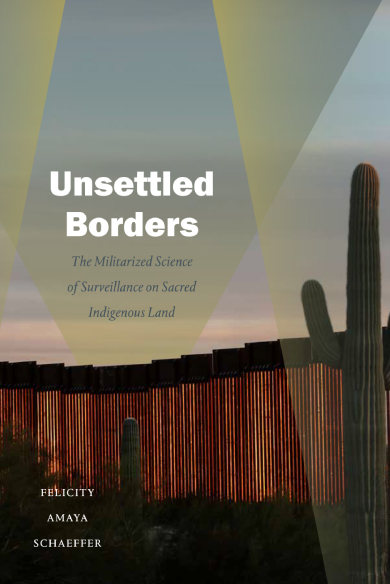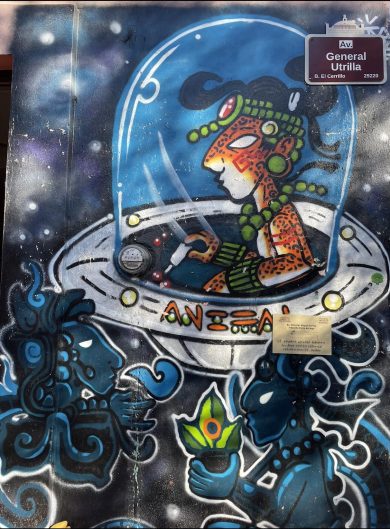Felicity Amaya Schaeffer is the Peggy and Jack Baskin Foundation Presidential Chair for Feminist Studies. She is also a Professor in the Critical Race and Ethnic Studies Department as well as an Affiliate Faculty in Latin American and Latinx Studies. Her first book, Love and Empire: Cybermarriage and Citizenship Across the Americas (New York University Press, 2013), follows Internet-mediated marriages across the United States, Colombia, and Mexico alongside neo-colonial fantasies of racial and gendered difference across borders. Her second book, Unsettled Borders: The Militarized Surveillance on Sacred Indigenous Land (Duke University Press, 2022) re-maps the virtual border war alongside the ongoing settler colonial war with Indigenous peoples. She was also one of the editors of the anthology Precarity & Belonging: Labor, Migration, and Noncitizenship (Rutgers 2021) and has published articles in a variety of international journals in Mexico, France, and Brazil, and U.S. journals such as Signs: Journal of Women in Culture and Society; American Quarterly; Catalyst: Feminism, Theory, Technoscience, and Sexualities Journal.
Unsettled Borders: Sacred Travel across Planetary Spacetimes
How people encounter borders depends a great deal on how surveillance cameras sort data to parse those on the move into categories of threat versus traveler.
As border surveillance regimes cast the eye of the state beyond its national borders, questions emerge as to which bodies and territories visually code as threat. How people encounter borders depends a great deal on how surveillance cameras sort data to parse those on the move into categories of threat versus traveler, with consequences for speeding up the mobility of some travelers and goods, while detaining, slowing, or ending the movement of migrants, refugees, and others. Less examined, however, is how bordering regimes occupy and incarcerate Indigenous people’s movements on their own land, a land dismembered by nation-state borders. Given that much focus on travel considers horizontal and human-centric movements across land, we might consider the vertical, planetary, and cosmic scale of both surveillance monitoring and Indigenous travel. Here I want to follow the vertical movement of border surveillance signals from the ground to outer space. These satellite radars interfere with Indigenous travel across their land and up toward the sky and cosmos where knowledge of seasons, weather, animal locations and abundant food sources sharpen how to maintain ecological balance with a land in constant motion.
Not only are many Indigenous peoples globally displaced from their land and forced to travel far from home, those still living on their land suffer the consequences of atmospheric violence by militarized border control. On the Tohono O’odham reservation that spans the Arizona-Mexico “border,” elders have publicly shared how the Department of Homeland Security’s (DHS) aerial weaponry of surveillance sensors surrounding them from multiple scales, block the pathways of communication between them and all earthly beings—the wind, mountains and the cosmos, including the sun, moon, and stars. The need for an unimpeded, quiet, and clear view of the sky is crucial for the O’odham to persist as a people. In order to protect the delicate balance of the land and people, rituals of movement follow the web of seasonal cues that shape everyday travel such as when to hunt, plant, harvest, and engage in pilgrimage and ceremony with others across a great distance. Their ability to preserve the balance and the health of land and people, including the communing power of drums and prayer, is blocked by helicopter wings buzzing frantically above them as well as decades of infrastructural occupation by mining and extraction companies, development projects, and the constant military presence of border patrol, surveillance towers, detention centers, airbases, and observatory towers.
Palestinians have long served as the laboratory for Israel’s arsenal of aerial surveillant technologies that contain and monitor their daily lives. Similar to other nations rushing to purchase orbital space slots, Israeli’s vertical outposts create a series of atmospheric obstacles for Palestinians to maneuver. Surveillance fleets of drones, planes, and towers, to tear gas and other weaponry are launched from satellite stations up in space where they increasingly monitor Palestinians from above.[1] At the same time, Palestinians created their own aerial imagery, or “community satellites” (cameras attached to kites), to find wells and graves on land they have been pushed off of by Israeli military that accuses them of “trespassing on their own land.”[2]

Cover of Unsettled Borders: The Militarized Science of Surveillance on Sacred Indigenous Land, by Felicity Amaya Schaeffer. Duke University Press 2022.
Back in the United States, Customs and Border Patrol (CBP) partnered with the Air and Maritime Operations (AMO) to ramp up their virtual border with Multi-Role Enforcement Aircraft equipped with radars that can see across land and water from a satellite communications system that patrols from so far above U.S. borders that they can cover “a 42 million square mile area that includes more than 41 nations, the Pacific Ocean, Gulf of Mexico, and Caribbean Sea.” These radars up in space can hone in so closely to earth that they can capture the digits of a license plate.[3] This planetary eye over the border will reinforce new ways of monitoring mass movements of displaced travelers, while expanding surveillance far beyond nation-state borders.
To assess the Indigenous borderlands from a planetary perspective, asks us to understand how military occupation imposes a secular planetary order onto sacred relations between earth and the cosmos. At the heart of many Indigenous creation stories are cycles of life and death within a cosmic journey. Vanessa Watt tells the story of skywoman, the first human who travels from a hole in the sky plummeting toward earth. As she falls, birds slow her down until turtle emerges from the water and offers his back to support her landing.[4] Skywoman tosses her gift of plant seeds across the earth in thanks. This story holds a powerful reminder that life can only be sustained through these reciprocal relations across all beings and scales. These motions of care fly in the face of a long tradition of Western religious hierarchical ordering of vertical space inherited from the Great Chain of Being. In this vertical ordering of space, gods and angels float fixed at the highest point of the heavens above a descending order of humans, animals, vertebrates, plants, down to the minerals beneath the earth. This map of life reinforces a moral story of life from the bottom up, or from the simple to the most intelligent or complex.
There is a great planetary necessity to learning with and helping to protect Indigenous sacred approaches with the cosmos.
Less familiar are Indigenous practices that have long based earthly living with the cosmos. From the reading of stars by seafarers, to earthworks mounds, and ancient pyramids across the Americas, the relation with the cosmos continues to provide guidance for sovereignty and right relations with land. The geometric patterns carved into earth mounds, archaeological sites, and woven into rugs and huipiles, hold memory and serve as portals for travel to multiple times and dimensions. Pyramids were precisely constructed geometric architecture that sharpened the direction of travel up toward the multiple levels of the cosmos. For example, early records of Maya King Pakal’s burial stone in Palenque, Chiapas (circa 615-693 A.D.) depicts him traveling from the underworld to upperworld through the Ceiba tree with a bird perched at the top and a snake on one of its branches. Together, the tree, bird and snake transport him from the tree’s roots in the underworld, to the trunk located in the human realm of the above world, and branches reaching up toward the upper reaches of the sky. Images of the sun, moon and stars bracket the frame as well as mathematical symbols and animals that helped him traverse the numerous levels of these three vertical terrain.

Murial in Chiapas, Mexico. Photograph by Felicity Amaya Schaeffer.
On the streets of Chiapas, I turned a corner and came face to face with a mural that defies temporal boundaries between ancient and modern in this translation of Pakal, ornamented in jade, taking off in a spaceship. Similarly, carved into the top of some of the temples in Tulum, are the Melipona bees who are venerated by the Maya for supporting human life and death, supporting plant life on earth and as transporters of human souls up to the skyworld. And as mentioned, the Tohono O’odham, like many Indigenous peoples today, pace their movement over land in rhythm with the seasons, moving with the abundance of the land, as a sacred pilgrimage to gather medicines and engage in ceremony. These movements participate in the motion of the cosmos, braiding footprints into the land as a constant reminder of peoples’ responsibilities and relationships to give gifts of life back to the land that supports them.
The demand for the abolition of borders, or for the DHS to de-occupy Indigenous land, must deal with the border regime’s strategic move to virtualize the border from more and more remote locations. In fact, the FTM towers being erected on the O’odham reservation were negotiated to the tribal council as a “less intrusive” solution to the alternative building of Donald Trump’s 30-foot metal wall. There is a great planetary necessity to learning with and helping to protect Indigenous sacred approaches with the cosmos. Access to an uncluttered and dark night sky, access to sacred mountains, and a more relational understanding of the long history of indigenous technological, mathematical, and scientific approaches to knowledge of the land from below the earth to the cosmos are critical for preserving the ecologies of life on earth and into outer space.
“Unsettled Borders: Sacred Travel across Planetary Spacetimes” is part of The Humanities Institute’s 2023 Travel Series. This series features contributions from a range of faculty and emeriti in the Humanities community at UC Santa Cruz – each of whom highlight connections between travel and their work or consider the role of travel in their fields. Throughout Spring quarter, be sure to look for these amazing essays in our weekly newsletter!
Banner Image: Frontera Tijuana, by Barbara Zandoval.
References
[1] Etzion 2020; Breiner 2021; and Jake Silver, forthcoming. For an understanding of the history of Occupation in relation to developments in spatial and population control also see: Eyal Weizman, Ariella Azoulay, Adi Ophir, Neve Gordon, Ariel Handel, and Sari Hanafi
[2] “Blurry Satellite Images of Palestine and Israel Make Rebuilding Harder,” Wired Magazine, Luis Romero, May 28, 2021. https://www.wired.com/story/blurry-satellite-images-palestine-israel-make-rebuilding-harder/.
[3] Written testimony of CBP Air and Marine Operations Assistant Commissioner Randolph Alles and CBP U.S. Border Patrol acting Chief Ronald Vitiello for a House Committee on Homeland Security, Subcommittee on Border and Maritime Security hearing titled “Transparency, Trust and Verification: Measuring Effectiveness and Situational Awareness along the Border,” Homeland Security, March 1, 2016: https://www.dhs.gov/news/2016/03/01/written-testimony-cbp-house-homeland-security-subcommittee-border-and-maritime.
[4] Vanessa Watt, “Indigenous place-thought & agency amongst humans and non-humans (First Woman and Sky Woman go on a European world tour!),” Decolonization: Indigeneity, Education & Society, Vol 2 (1), 2013: 20-34. connection between place, non-human and human in an effort to access the “pre-colonial mind”.
Keywords: vertical borders, outer space, planetary, Indigenous knowledges, land